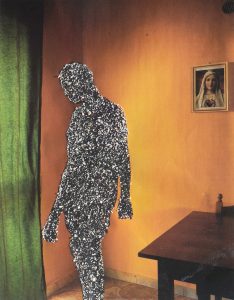COLORS play tricks on us. What we see is not always what we get. And what we think is not always what we see. Is seeing the same as perception? Is white the binary opposite of black? Can one exist without the other?
As a queer, white, male artist, I’m closely following the political “deconstruction of the administrative state.” The unraveling of our historic democratic underpinnings demands a deep resourcefulness and an intersectional creative response. Issues of race, ethnicity, and the marginalization of otherness are there at the origins of our democratic foundations. Black Lives Matter’s agenda is queer-affirming and has as a guiding principal to do the work required “to dismantle cisgender privilege and uplift Black trans folk.”
There is a heightened awareness of the fragility of significant civic benchmarks such as same-sex marriage, voting rights (particularly vulnerable in cities, with a concentration of LGBT people and people of color), environmental protections, HIV, and affordable health care.
Race and otherness are inextricably linked. Two of my recent projects tackle these issues: People of Colors and The Whiteness House: Tarred and Feathered.
How white is the White House? What shade of white is it? The house as a national symbol takes on an ominous presence with a white president whose campaign was substantially based on color—along with misogyny, white privilege, homophobia, fear, etc.—following a black president. How white is a Whiteness House after a black president? How does a white house express its whiteness?
The Whiteness House—Tarred and Feathered proposes to build a walk-in scale model of the White House, tar and feather the exterior, and activate it collaboratively with other artists and activists. Tarring and feathering is a form of public humiliation used to enforce unofficial justice or revenge. It was used in feudal Europe and in colonial America, mostly as a type of mob vengeance. It is meant to humiliate and severely criticize a person.
So what are some of the associations that whiteness evokes? Let’s take a look: White Christmas, white flight, whitewash, a white elephant, Snow White, white collar, a white Russian, whiteout, white supremacy, white race films, white light, white lightning, black-and-white mixed race films, whitened teeth.

The natural materials of down feathers and sand remind us of our connection to the materiality and ecology of the planet. I’ve been covering up objects, initially with sand, and redefining their significance since the 1980s. People of Colors employs naturally colored sand as paint, drawing on recent fashion magazine advertisements. Working with the sands of time for over thirty years—encrusting cars and a motel, sandblasting and filling a car—these sand drawings seem frail and intimate. Fracturing the stylized gloss of the flimsy paper with the rawness of sand exposes the bones and artifice of the human body on the flat page.
How is our perception of an image altered when a gritty veil or mask of sand is applied in this People of Colors series? The sand may be black, white, pink, orange, or beige. What shades of color do we perceive? What shades of color do we defy?
Jay Critchley is an installation and performance artist based in Provincetown, Mass.






